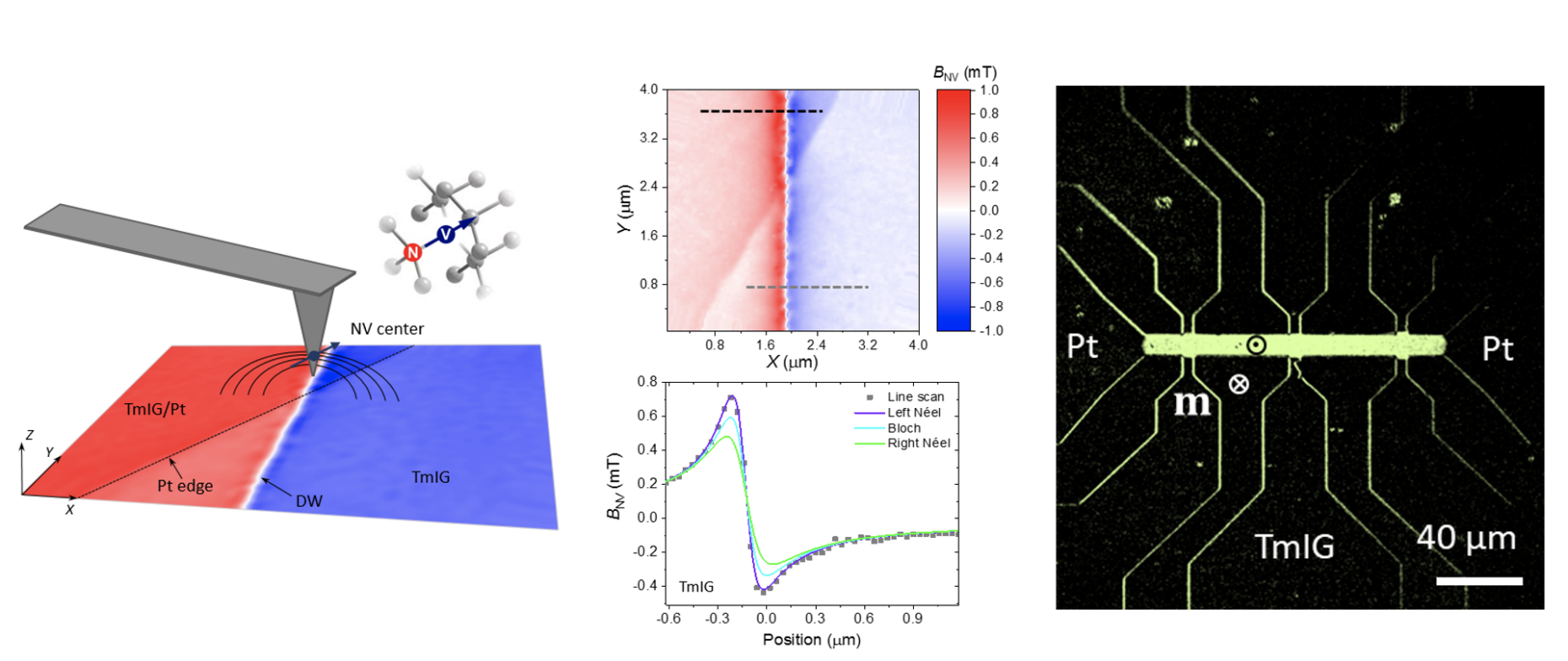Spintronics in magnetic insulators
Electrical probing and switching have long been precluded for magnetic insulators. Recently, thanks to the spin-charge conversion processes that occur when an electric current is passed through a thin metal layer adjacent to an insulating ferromagnet or ferrimagnet, both phenomena have been demonstrated. The materials of choice are often nm-thick magnetic garnet layers, whose magnetic properties like anisotropy and damping can be tuned with great accuracy. In our group, we study the structure and magnetic properties of ultrathin yttrium iron garnet (YIG) and thulium iron garnet (TmIG) layers grown by pulsed laser deposition and sputtering, as well as methods to selectively induce current-induced domain wall motion and switching in pre-defined areas of the YIG or TmIG samples.

High-speed domain wall racetracks in a magnetic insulator
Recent reports of current-induced switching of ferrimagnetic oxides coupled to heavy metals have opened prospects for implementing magnetic insulators into electrically addressable devices. However, the configuration and dynamics of magnetic domain walls driven by electrical currents in insulating oxides remain unexplored. Here we investigate the internal structure of the domain walls in Tm3Fe5O12 (TmIG) and TmIG/Pt bilayers, and demonstrate their efficient manipulation by spin–orbit torques with velocities of up to 400 ms−1 and minimal current threshold for domain wall flow of 5 × 106 A cm−2. Domain wall racetracks are defined by Pt current lines on continuous TmIG films, which allows for patterning the magnetic landscape of TmIG in a fast and reversible way. Scanning nitrogen-vacancy magnetometry reveals that the domain walls of TmIG thin films grown on Gd3Sc2Ga3O12 exhibit left-handed Néel chirality, changing to an intermediate Néel–Bloch configuration upon Pt deposition. These results indicate the presence of interfacial Dzyaloshinskii–Moriya interaction in magnetic garnets, opening the possibility to stabilize chiral spin textures in centrosymmetric magnetic insulators.
Nucleating and driving skyrmions in magnetic insulators
Skyrmions are continuous swirls of the magnetization resulting from magnetic moments winding up around a central core with a unique sense of rotation (a.k.a. chirality). They occur in systems where the Dzyaloshinskii–Moriya interaction promotes noncollinear alignment of magnetic moments. Skyrmions are presently investigated as carriers of nonvolatile magnetic information for both boolean and neuromorphic logic and computation schemes. Most studies in this area, however, have been performed on metallic ferromagnets, which involve electrical losses and are limited in operational frequency. Insulating ferrimagnets can overcome these limitations, but the manipulation of skyrmions in these systems is challenging. Here we provide a demonstration of skyrmions nucleation, stabilization, and current-induced dynamics in a ferrimagnetic insulator at room temperature coupled to a conducting Pt layer. Owing to the interfacial Dzyaloshinskii–Moriya interaction and low magnetic anisotropy of this structure, we show that skyrmion bubbles can be nucleated and stabilized in Tm3Fe5O12 (TmIG) by applying current pulses to the Pt overlayer. Further, by tracking the skyrmions’ trajectories following a sequence of current pulses, we show that the skyrmions exhibit hopping-like dynamics and respond to spin-orbit torques, pinning, and thermal excitations differently than in conventional ferromagnetic and ferrimagnetic metals. In particular, the skyrmion Hall effect is opposed to that of ferromagnets due to the positive angular momentum of TmIG, and unusually strong due to the low concentration of defects and low damping of the films. Finally, we demonstrate a novel scheme to tune the mobility of skyrmions, which has general application to skyrmions driven by spin-orbit torques.
Overall, our results open the way to realize skyrmion devices in magnetic insulators, highlighting new possibilities to tune the skyrmion mobility as well as the challenges that need to be overcome in order to achieve efficient skyrmion motion.

Selected Publications
- Magnon transport and thermoelectric effects in ultrathin Tm3Fe5O12/Pt nonlocal devices, J. Gao, C.-H. Lambert, R. Schlitz, M. Fiebig, P. Gambardella , and S. Vélez, Phys. Rev. Res. 4, 043214 (2022). Download article (PDF, 1.9 MB)
- Current-driven dynamics and ratchet effect of skyrmion bubbles in a ferrimagnetic insulator, S. Vélez, S. Ruiz-Gómez, J. Schaab, E. Gradauskaite, M. S. Wörnle, P. Welter, B. J. Jacot, C. L. Degen, M. Trassin, M. Fiebig and P. Gambardella, Nat. Nanotech. (2022) Download article (PDF, 5.2 MB)
- Control of Nonlocal Magnon Spin Transport via Magnon Drift Currents. R. Schlitz, S. Vélez, A. Kamra, C.-H. Lambert, M. Lammel, S. T. B. Goennenwein, P. Gambardella, Phys. Rev. Lett. 126, 257201 (2021) Download article (PDF, 508 KB), Download supplementary information (PDF, 2.3 MB), Viewpoint: A New Drift in Spin-Based Electronics, Download Physics 14, 92 (2021) (PDF, 123 KB)
- High-speed domain wall racetracks in a magnetic insulator, S. Vélez, J. Schaab, M. S. Wörnle, M. Müller, E. Gradauskaite, P. Welter, C. Gutgsell, C. Nistor, C. L. Degen, M. Trassin, M. Fiebig and Pietro Gambardella, Nat. Comm. 10, 4750 (2019). Download article (PDF, 1.6 MB)
- Magnetic properties and domain structure of ultrathin yttrium iron garnet/Pt bilayers, J. Mendil, M. Trassin, Q. Bu, J. Schaab, M. Baumgartner, C. Murer, P. T. Dao, J. Vijayakumar, D. Bracher, C. Bouillet, C. A. F. Vaz, M. Fiebig, and P. Gambardella, Phys. Rev. Materials 3, 034403 (2019). Download article (PDF, 1.9 MB)
- Current-induced switching of YIG/Pt bilayers with in-plane magnetization due to Oersted fields, J. Mendil, M. Trassin, Q. Bu, M. Fiebig, and P. Gambardella, Appl. Phys. Lett. 114, 172404 (2019). Download article (PDF, 1.5 MB)
- Current-induced spin-orbit torques in ferromagnetic and antiferromagnetic systems, A. Manchon, J. Železný, I.M. Miron, T. Jungwirth, J. Sinova, A. Thiaville, K. Garello, and P. Gambardella, Rev. Mod. Phys. 91, 035004 (2019). Download article (PDF, 12.4 MB)